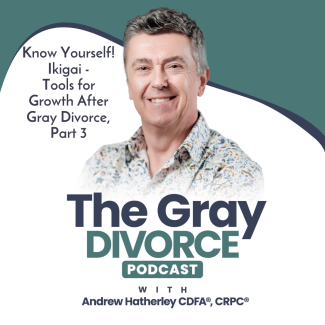
The Gray Divorce Podcast: Episode 29 Know Yourself! Ikigai - Tools for Growth After Gray Divorce, Part 3
In Episode 29 of the Gray Divorce Podcast, we continue our discussion on the importance of better understanding ourselves before, during, and after mid to late-life divorce.
This episode deals with the important theme of finding purpose in life. In Japanese culture, to find meaning and purpose in life is known as finding your ikigai.
A person's ikigai can be a passion, a goal, a mission. It’s something that gives each day meaning. Discovering your ikigai may require patience, commitment, and a lot of introspection. For some people it may be easy to figure out what their ikigai is, for others it may be a lifelong search.
There are four key components to the concept of ikigai.
These are:
1. What you love
2. What you’re good at
3. What you can get paid for
4. What the world needs.
To discover your Ikigai you must first identify these four components. Ikigai is then found at the point where these four elements converge.
Ikigai is best illustrated by four overlapping circles, like a Venn diagram. Try this exercise: draw four overlapping circles. There will be a top circle, a bottom circle, a left circle and a right circle and they'll all cross each other in the middle.
Above the top circle write the three words “what I love.” Take a few minutes to think about the things you love in any aspect of your life. This could be work, hobbies, personal interests. Some examples might be travel, teaching, guitar, writing, golf. Write these things inside at the top of the circle.
Next, just underneath the bottom circle right the heading “What can I be paid for”. Here you might write down, just inside the circle, bookkeeping, photography, writing, teaching.
Do the same with the left circle for “What I'm good at.” For example, this might include photography, writing, helping others, organizational skills, teaching others, listening, bookkeeping.
Finally on the right circle consider “What the world needs”. In our example, let’s consider compassion, freedom, sense of community, access to healthcare, access to a good education, friendship, a sense of community.
Of course, what you put in these various circles is going to reflect your particular interests and worldview. Don't be surprised if it takes you longer than you might have imagined to think of things you love, things you're good at, what you can get paid for and what the world needs.
By now you've probably figured out that if some activity that you’ve listed appears in all four circles well, then, you’ve found your Ikigai. When any response appears in what you love, what you're good at, what you can be paid for, and what the world needs you’ve found your Ikigai.
Some people are really fortunate in that they're able to determine their purpose or Ikigai quite quickly.
It's very likely that you may not have this one magical activity at the center of these four circles. You shouldn’t despair. Finding Ikigai may require some work on your part, and it may not happen overnight.
Of course, life is a journey. And the more self-aware we can be about the experiences we have on our life's journey, the more likely we are to find our ikigai or purpose.
Resources
Ikigai: The Japanese Secret to a Long and Happy Life by Hector Garcia and Francesc Miralles
https://www.betterup.com/blog/what-is-ikigai
https://positivepsychology.com/ikigai-worksheets-templates/

